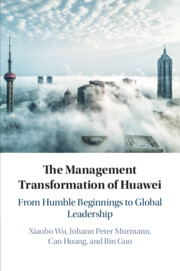Book contents
- The Management Transformation of Huawei
- The Management Transformation of Huawei
- Copyright page
- Contents
- Figures
- Tables
- Contributors
- Preface
- 1 The Management Transformation of Huawei
- 2 The Executive Management Team and Organizational Change
- 3 Transforming Product Development at Huawei
- 4 Huawei’s Transformation of Supply Chain Management
- 5 Financial Management Transformation in Huawei
- 6 The Transformation of Huawei’s HR System
- 7 Huawei’s Internationalization Journey
- 8 Huawei’s R&D Management Transformation
- 9 Huawei’s Intellectual Property Management Transformation
- 10 The Management Transformation of Huawei
- Book part
- Index
- References
5 - Financial Management Transformation in Huawei
Published online by Cambridge University Press: 21 March 2020
- The Management Transformation of Huawei
- The Management Transformation of Huawei
- Copyright page
- Contents
- Figures
- Tables
- Contributors
- Preface
- 1 The Management Transformation of Huawei
- 2 The Executive Management Team and Organizational Change
- 3 Transforming Product Development at Huawei
- 4 Huawei’s Transformation of Supply Chain Management
- 5 Financial Management Transformation in Huawei
- 6 The Transformation of Huawei’s HR System
- 7 Huawei’s Internationalization Journey
- 8 Huawei’s R&D Management Transformation
- 9 Huawei’s Intellectual Property Management Transformation
- 10 The Management Transformation of Huawei
- Book part
- Index
- References
Summary
Management transformation in the financial management area has contributed significantly to the competitiveness of Huawei. Four Standardizations was the first large-scale financial management transformation project implemented in the company from 1998 to 2007. In 2007, Huawei started a more ambitious Integrated Financial Services project with assistance from IBM consultants, which lasted until 2014. This chapter documents the background, motivation, activities and impacts of these two financial management transformation projects and discusses Huawei’s experience in successfully implementing management transformation in the financial area. It also highlights that Huawei’s employee ownership and financial management strategy with its own characteristics determine the focus of the financial management transformation projects.
Keywords
- Type
- Chapter
- Information
- The Management Transformation of HuaweiFrom Humble Beginnings to Global Leadership, pp. 171 - 208Publisher: Cambridge University PressPrint publication year: 2020
References
References
References
- 1
- Cited by



